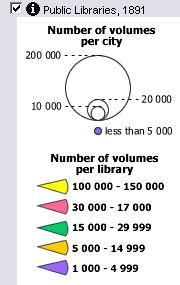|
|
||||||
Area units: Data units: |
 |
Settlement |
 |
Checkbox controls the visibility of the coloured circles representing the establishment date of each collective library. |
 |
Checkbox controls the visibility of the coloured circles representing the establishment date of each mechanic's institute. |
 |
Checkbox controls the visibility of the proportional pie graphs representing public libraries. The size of each pie graph is proportional to the number of volumes in all libraries in a particular city. If the pie graph is undivided into wedges, then there was only one library in that city. If it is subdivided into wedges, then each wedge represents one library, and is proportional to the number of volumes at that library. The colour of each circle or wedge represents the general size of the library in terms of number of volumes. |
 |
Checkbox controls visibility of Modern Geography (current provincial and territorial boundaries, as well as selected cities), and is available for reference. |
| Active layer: Checkbox for Public Libraries, 1891 must be checked in order to make it the active layer. | |
Identify: Click on any of the library pie graphs to display the name of that particular city or town. |
|
| Table: Click or drag a rectangle to select any of the library pie graphs. A table pops up showing library information by city or town. See Table Fields below. |
| Province | Province in which the newspaper was circulated. |
| City or Town | City or town that the newspaper's content was focused on, and in which it was circulated. |
| Number of volumes | Total number of volumes at all libraries in that city or town. |
| Number of libraries | Total number of libraries in that city or town. |
|
The public library as we understand it did not exist before the end of the 19th century. The first public-access libraries in Canada date from the Québec Library of 1779. We call such institutions collective libraries because they served groups of people who had need of specific books. They might be owned jointly by shareholders who formed an association with the express purpose of organizing a library, or they might be established as adjuncts to professional bodies, such as a bar association or medical society, or they might be subscription libraries supported by membership fees and bequests. The immediate precursor of the public library was the Mechanics' Institute. Mechanics' Institutes originated in Britain in 1823 as voluntary educational associations of apprentices and labourers looking for ways to expand their skills in an increasingly technical world. The York Mechanics' Institute was established in 1830. Two years later the York Typographical Society, predecessor of the oldest trade union in Canada, was founded. Presumably the printing and allied trades would have been moving forces in the creation of the Institutes. Their workers were both literate and highly skilled in the increasingly technical sphere of communication. By 1895, when provincial legislation effectively converted them into public libraries, there were in Ontario approximately 300 Mechanics' Institutes, of which over 30% contained more than 1,000 volumes each.
Parish libraries in rural Québec reflected ultramontane pressure to oppose the Instituts canadiens. The first Institut canadien was founded in Montréal in 1844 and was emulated in over 50 centres thereafter. The Instituts were havens for intellectual discussion and animated political debate and often maintained libraries containing a rich array of secular, often controversial, publications, including newspapers. When the Church triumphed, stamping out most of the Instituts by 1885, the library of the Montréal Institut canadien was amalgamated with the famous Mercantile Library after being purchased by the Fraser Institute. In 1891 the Fraser Institute could circulate 30 000 volumes. In the 19th century 165 libraries (21 of them parish libraries) were founded in Montréal alone. Although few were large and few survived intact into the 20th century, their holdings were gradually consolidated and continued to serve the community. For example, the Cabinet de lecture paroissial de Montréal (1857) absorbed the ultramontane-inspired (Euvre des bons livres (1844), and together they constituted the backbone of the Bibliothèque Saint-Sulpice (1915), which evolved into the Bibliotheque nationale du Quebec (1967). On our maps neither parish nor Sunday school libraries have been included, but it should not be assumed that they were always small or that their titles were invariably sectarian. Only the principal libraries of the universities and classical colleges appear in our analysis. The latter are particularly important; Yvan Lamonde has shown that between 1856 and 1881 they contained almost 50% of the volumes held by all educational institutions in Québec, including universities, academies, écoles normales, and écoles modèles. Were it possible to map all school, township, parish, convent, semi¬nary, Sunday school, trade union, hospital, personal, business, and traveling libraries across the country, one would be struck at once by the extraordinary number of institutions housing books and by their widespread distribution. Still, urban centres contained the largest and most cosmopolitan collections, while the population remained predominantly rural. |